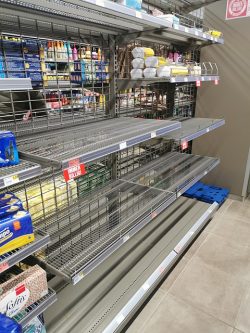
I was watching a crime drama on TV the other day. The cops were able to identify a drug user because she kept sniffing when they interviewed her.
But then I did a little digging. And as it turns out, drug use causes far more damage than a case of the sniffles. It can really wreak havoc on your nose.
If that woman really did snort drugs long-term, she would’ve had some serious symptoms that go way beyond a runny nose.
Here’s a breakdown of how drugs can damage your nose.
Membrane Damage: Stuffy Nose & Nosebleeds
 Inside your nose, you’ll find a mucous membrane lining that covers the entire interior.
Inside your nose, you’ll find a mucous membrane lining that covers the entire interior.
The point of this lining is to warm and humidify the air you inhale. The lining also helps to trap the debris and pathogens lingering around in that air, preventing them from entering your body and causing illness.
But snorting drugs (like OxyContin, heroin, cocaine, meth, etc.) damages the lining and decreases blood flow in the nose. The damage causes blockage in your airways, which results in a stuffy nose. The reduced blood flow also causes blood vessels to shrink and burst, which results in nosebleeds.
Deviated Septum: Breathing Problems & Infections
Over time, repeated damage to the mucous lining and the cartilage in your nose begins to affect the septum (the part that divides your nose into two nostrils). This damage causes the septum to become uneven or misaligned. This is referred to as a deviated septum.
A deviated septum can cause a host of problems. The most common issues are congestion and breathing problems. But this damage can also cause sleeping problems, headaches, pain in the face, snoring, and frequent sinus infections.
Perforated Septum: Nose Decay & Death
With long-term use, drugs that are snorted continue to eat away at the septum. Eventually, the damage goes beyond simply misshaping the septum to killing it. As the cells die off, a hole forms. This is called a perforated (punctured) septum.
A perforated septum can cause your nose to feel blocked, can cause whistling or wheezing in the nose, and can result in headaches, nosebleeds, nose pain, and scabbing inside your nose.
Palate Damage: Swallowing Issues
 Here’s where the damage moves beyond your nose. With long-term drug abuse, the substances can start to damage the roof of your mouth (the hard palate).
Here’s where the damage moves beyond your nose. With long-term drug abuse, the substances can start to damage the roof of your mouth (the hard palate).
Your palate is located right next to your nose, and the reduced blood flow and irritation of the nasal passages eventually spreads here. The damage eats away at the bone cells, causing a hole to form in the top of your mouth.
When this happens, you’ll have difficulty swallowing, food may come out of your nose when you eat or drink, and you may develop a nasally voice.
Saddle Nose: Permanent Disfiguring
And now we’ve come to the point where the damage has become very visible. Repeated damage to the septum can eventually weaken it so much that the nose collapses.
Your nose looks wider and flatter. The middle of your nose is no longer be supported by the septum, so it has a saddle-shaped depression in the middle (a “saddle nose”).
Warning Signs Your Nose is Damaged By Drugs
The good news is that some of these issues will go away if drug use stops. Others are more severe and can cause permanent damage. Saddle nose, for instance, will require surgery to repair your nose.
But who wants to get to that point?
Watch for the following warning signs that drug use is causing damage to your nose. (Or look for these signs if you suspect a loved one is struggling with a drug addiction. Like the detectives in that crime show, you can use these clues to spot drug use.)
- Nasal pain
- Loss of smell
- Nose bleeds
- Frequent sinus infections
- Whistling noises in the nose when breathing
Don’t Let Drugs Damage Your Nose Permanently
Don’t wait around and let your nose damage become severe. It can happen quickly.
The hard truth is a stuffy nose can turn into a deviated septum in no time. And it will only get worse. The only way to stop this damage is to stop drug use. How? Learn more about treatment here.
If you or someone you love is experiencing a substance use disorder, help is available. Call 800-934-1582(Sponsored) today.

69,710.
That’s the number of people who died from opioid overdose in the U.S. in 2020. That’s up nearly 30 percent from the year before. And many expect those numbers to continue rising.
And why wouldn’t they? As we see more and more drugs laced with deadly doses of fentanyl, overdoses are becoming more and more likely. What’s the solution? Better interventions? More awareness? Fewer prescriptions? Policy makers, law enforcement, and health officials are looking into these options and many more.
Meanwhile, one group suggests going with a solution that’s less mainstream. In fact, it’s less…legal. (At least for now.) Enter the Safe Supply movement.
Introducing the Safe Supply Movement
The Drug User Liberation Front (DULF) took to the dark web and introduced their own solution: Safe Supply. DULF hopes policies change in the future and they can garner support off the dark web. For now, they’ll take what they can get.
 DULF founders Jeremy Kalicum and Eris Nyx seek to provide drug users with the drugs they want – but with less risk of overdose. How? By purchasing the drugs and testing them before they are passed on.
DULF founders Jeremy Kalicum and Eris Nyx seek to provide drug users with the drugs they want – but with less risk of overdose. How? By purchasing the drugs and testing them before they are passed on.
With fentanyl showing up in opioids, cocaine, and meth these days, DULF founders hope to intercept these deadly drugs before they hit the streets and ultimately provide a “safe supply” for users.
With overdose numbers climbing, the founders upped their game over the past two years. Last year, they staged their first protest, demanding a “safe supply” of drugs.
And in April of this year, they distributed pre-tested heroin in downtown Vancouver. And this past July, in what was likely their boldest move yet, DULF distributed drugs in front of Vancouver police HQ.
What’s in the Bag?
Nyx and Kalicum point out that no one really knows what they’re getting their hands on when they buy drugs in unmarked bags. Dealers could be giving them anything – and they often are. With just a few surprise milligrams of fentanyl in the mix, the user easily becomes another overdose statistic.
So, DULF founders hope to follow the same model as alcohol and cigarette distributors. They want to test the ingredients and label the substances clearly. They’d test street drugs and distribute them in packaging that clearly states what’s inside. Clients and groups could get their supply from DULF at protest events.
Kalicum admits that purchasing the drugs is a lot like buying anything else online – but you’re not using eBay or Amazon. He buys drugs on the dark web.
Kalicum admits that purchasing the drugs is a lot like buying anything else online – but you’re not using eBay or Amazon. He buys drugs on the dark web, a virtually unregulated sector of the Internet that offers sites where people can buy drugs and even leave reviews for the vendors. If Kalicum gets fentanyl when he is supposed to get heroin, he can dispute the purchase and ask for a refund (and has done so).
Of course, Kalicum admits, he might be purchasing from a criminal organization and further funding their illicit efforts. “But, we’re forced to leverage the resources that we have access to,” Kalicum argues.
Kalicum uses an allegedly untraceable cryptocurrency for the purchases, then he tests the drugs using FTIR spectroscopy. This technology reveals what is in the substance using infrared light. Then, Nyx makes labels for the Safe Supply drugs and tracks data on the substances they distribute.
What’s Next for the Safe Supply Movement?
 Kalicum notes they would prefer to use drugs provided by the government rather than illicit markets. He hopes other drugs become regulated, much like methadone is now. He and other DULF supporters are making efforts to implement a “safe supply” model and bring Canadian health officials onboard.
Kalicum notes they would prefer to use drugs provided by the government rather than illicit markets. He hopes other drugs become regulated, much like methadone is now. He and other DULF supporters are making efforts to implement a “safe supply” model and bring Canadian health officials onboard.
In August, DULF founders submitted a request for exemption to current policies so they could practice their “safe supply” model – due to the “health emergency” of the opioid crisis.
And the duo is actually gaining some official support. Vancouver Coastal Health, a regional health authority, gave DULF a letter of support for its plan. Some Canadian policy experts have also agreed to support DULF’s safe supply efforts.
In October, the Vancouver City Council voted to support DULF’s efforts, but only if they purchase the drugs legally. This will require cooperation from other organizations, such as Fair Price Pharma, to provide the supply.
Nyx and Kalicum see a long road ahead, but they continue to push the “safe supply” movement. Nyx noted in an interview, “We have a colossal amount of work to do. People are constantly dying, and there is no end in sight.”
If you or someone you love is experiencing a substance use disorder, help is available. Call 800-934-1582(Sponsored) today.

The Attorney General in Alabama has designated a good chunk of its opioid crisis settlement money go towards an impressive cause.
In a series of attempts to right the wrongs that opioids caused the state, Alabama will allocate $1.5 million of their McKinsey & Company settlement to the Department of Child Abuse and Neglect Prevention. Additional funding will be allotted to several more critical law enforcement departments.
Opioid Settlement Money From McKinsey & Company
Earlier this year, The New York Times reported the consulting firm McKinsey & Company agreed to pay nearly $600 million to settle investigations into their role in increasing opioid sales. One of the drug companies it gave sales advice to was Purdue Pharma, the manufacturer of the highly addictive drug OxyContin.
 McKinsey reportedly wrote a report for Purdue executives highlighting how their new marketing tactics could increase sales of highly addictive OxyContin by $200 to $400 million annually. The report included a suggestion that opioids are useful in reducing stress, making patients feel optimistic, and helping them feel less isolated. One might argue that’s the complete opposite of how opioid addiction presents – constant cravings, discontent, isolation, and symptoms of physical dependence.
McKinsey reportedly wrote a report for Purdue executives highlighting how their new marketing tactics could increase sales of highly addictive OxyContin by $200 to $400 million annually. The report included a suggestion that opioids are useful in reducing stress, making patients feel optimistic, and helping them feel less isolated. One might argue that’s the complete opposite of how opioid addiction presents – constant cravings, discontent, isolation, and symptoms of physical dependence.
Purdue Pharma was also found to be at serious fault in the opioid crisis by knowingly putting the well-being of millions of Americans at risk by marketing and selling opioids that it knew were dangerous. It was also alleged that the company had reason to believe some of the providers were diverting the drugs to people who were abusing them. In November last year, Purdue pleaded guilty to fraud and kickback conspiracies.
Purdue agreed to an $8.3 billion settlement and plead guilty to criminal charges for its role in fueling the opioid crisis. McKinsey & Company agreed to a nearly $600 million settlement in order to end investigations into their role in helping Purdue “turbocharge” its opioid sales.
Alabama Isn’t Wasting Its Opioid Settlement Money
Alabama sued McKinsey for their role in increasing opioid sales and were awarded $9 million, $7.6 million of which is due to be paid in 2021. (Alabama also has several other pending lawsuits against opioid manufacturers.)
In a series of statements, the Alabama Attorney General announced the state would be awarding millions of dollars to the Alabama Department of Child Abuse and Prevention (ADCANP), their forensic lab, and specialty courts.
Alabama’s settlement with McKinsey & Company was the first multistate opioid settlement to address the crisis, totaling $9 million.
Here’s a breakdown of all three monetary awards:
#1 Opioids and Child Abuse
Official data suggests that a large percentage of children enter foster care in Alabama due to substance use. Child neglect accounts for 60 percent of child removal from their homes.
Speaking about this intervention, the Marshall stated:
“The Alabama Department of Child Abuse Neglect and Prevention is a small state agency with a critical mission – strengthening families. I firmly believe that strong families are the answer to nearly every societal ill that our state is wrestling with, not the least of which is the opioid crisis.”
Marshall went on to say that he believes “…children are the invisible victims of the opioid epidemic.”
#2 Opioid Forensic Testing
The settlement awarded to Alabama’s forensic lab, which serves all 450 enforcement agencies in the state, is intended to improve the quality and turnaround of forensic services for opioid-related cases.
“Our state forensics lab, like so many across the country, has been battling backlogs caused by the opioid epidemic. This investment in new technology will give ADFS the tools they need to quickly identify trends in increasingly complex synthetic opioids and to aid law enforcement in identifying opioid traffickers,” Marshall said.
#3 Specialty Courts
 The Attorney General awarded the Office of Prosecution Services and officers from the Alabama District Attorneys Association $1.5 million to invest in specialty courts, including drug courts, veterans’ courts, and mental health courts.
The Attorney General awarded the Office of Prosecution Services and officers from the Alabama District Attorneys Association $1.5 million to invest in specialty courts, including drug courts, veterans’ courts, and mental health courts.
Specialty courts, as they suggest, have a specific criminal justice reform role: treating offenders whose crime is related to substance use disorder and reducing recidivism. Attorney General Marshall believes that investing in drug courts is a way of relieving the strain of the opioid epidemic placed on their District Attorney’s offices and court systems.
Speaking about this investment on behalf of the District Attorney’s Association, DA Michael Jackson spoke of its potential value:
“Drug courts and pretrial diversion programs are an extremely valuable tool – not only can this type of intervention save the lives of addicted offenders, but these programs also help decrease victimization within communities.”
More Opioid Settlement Money on the Horizon?
And it isn’t over yet. Alabama is still set for trials with other pharmaceutical companies, including Endo Pharmaceuticals and McKesson Corporation. It also has pending litigation against opioid manufacturers Purdue Pharma, Mallinckrodt, and Insys.
If you or someone you love is experiencing a substance use disorder, help is available. Call 800-934-1582(Sponsored) today.

“I just need a way out of my head. I’ll do anything for a way out of my head.”
These are the lyrics from Mac Miller’s platinum track “Come Back To Earth.” The song’s album, Swimming, achieved platinum status in February of 2021 – two and a half years after the rapper’s death.
It was Miller’s first album to go platinum.
Why didn’t Miller live to see his own success? Because on September 4, 2018, he was given counterfeit oxycodone pills. The drugs contained fentanyl, which is deadly in even the smallest doses.
Apparently unaware of the fentanyl laced into of the pills, Miller overdosed three days later. He died on September 7 from what the coroner labeled “mixed drug toxicity” – a combination of fentanyl, alcohol, and cocaine.
He was just 26 years old.
Dealer Knowingly Provided Pills Laced With Fentanyl
 Fast forward to October 2021. Miller’s songs are going double platinum, and the dealer who supplied the fentanyl-laced drugs has pled guilty of the crime. The dealer, Stephen Andrew Walter, now faces up to 20 years in prison and a fine of up to $1 million.
Fast forward to October 2021. Miller’s songs are going double platinum, and the dealer who supplied the fentanyl-laced drugs has pled guilty of the crime. The dealer, Stephen Andrew Walter, now faces up to 20 years in prison and a fine of up to $1 million.
What happened, exactly?
According to the plea, Walter told a drug runner to give counterfeit oxycodone pills containing fentanyl to Miller’s dealer, who then provided them to Miller.
Walter admits he knew the pills “contained fentanyl or some other federally controlled substance.”
The plea also notes that, if it weren’t for the fentanyl in the pills, Miller would not have died from an overdose. But, because Walter supplied the laced drugs, Miller suffered a fatal overdose three days after receiving them.
Walter’s plea is guilty to one count of distributing fentanyl. The dealer and runner have also been charged.
Mac Miller’s Struggle With Opioid Addiction
Mac Miller, born Malcolm James McCormick, released five rap albums before his death. He was open about his struggle with sobriety, and his lyrics frequently referenced substance abuse.
Just four months before his fatal overdose, Miller crashed into a light pole while driving under the influence. Miller reported that the experience changed his perspective on life. But it clearly didn’t push him to total sobriety.
“I would just tell myself to worry a little less and…don’t create all of this weight for things. Everything has so much weight, but it’s all just chapters. It’s all just pieces of the story. There’s gonna be a next part.”
Miller was preparing to take his newest album, Swimming, on tour when the fentanyl-laced drugs landed in his hands. In one of his last interviews before the overdose, the rapper noted, “There’s pressure. A lot of times in my life I’ve put this pressure to hold myself to the standard of being whatever I thought I was supposed to be, or how I was supposed to be perceived. And that creates pressure.”
When asked what he would tell his younger self, Miller replied, “I would just tell myself to worry a little less and…don’t create all of this weight for things. Everything has so much weight, but it’s all just chapters. It’s all just pieces of the story. There’s gonna be a next part.”
Too Many Americans Never Made It to the Next Chapter
Miller was just one of nearly 30,000 people who died of opioid-related overdoses in 2018. The next year, the total jumped to 50,000.
 This year, drug enforcement agencies are reporting unprecedented amounts of fentanyl in the drugs they confiscate. And stress from the ongoing pandemic seems to be escalating the crisis.
This year, drug enforcement agencies are reporting unprecedented amounts of fentanyl in the drugs they confiscate. And stress from the ongoing pandemic seems to be escalating the crisis.
Between May 2019 and May 2020, there were over 81,000 drug overdose deaths in the U.S. That’s a record-breaker for any 12-month period, according to the CDC.
What’s next? Will we see the numbers continue to rise? Will we find new solutions to reach people and prevent future deaths like Mac Miller’s?
We’ll let his words speak for themselves:
“Somehow we gotta find a way
No matter how many miles it takes
I know it feels so good right now
But it all come fallin’ down.”
Get help today at 800-934-1582(Sponsored) to learn about treatment programs for drug and alcohol addiction.

Darknet fentanyl. A 10-month investigation across three continents. Dozens of law enforcement agencies. This was no small operation.
And it paid off.
After careful coordination among nine countries, operation “Dark HunTor” took 500 pounds of illicit drugs off the market – along with $32 million in cash and 45 firearms.
The far-reaching drug enforcement operation was designed to send a message to people peddling illegal drugs: “There is no dark internet.”
No More Hiding in the Dark for Darknet Fentanyl
The dark web has become a playground for online peddling of pills laced with fentanyl.
 Dealers have found new ways to push drugs, post their offerings, and package them like any other online purchase.
Dealers have found new ways to push drugs, post their offerings, and package them like any other online purchase.
“Today, we face new and increasingly dangerous threats as drug traffickers expand into the digital world and use the Darknet to sell dangerous drugs like fentanyl,” noted Administrator Ann Milgram of the Drug Enforcement Administration (DEA).
When researchers interviewed dealers on the dark web, they discovered that it has (seemingly) offered a “safe” space for illegal sales, attracting new criminals and illegal “entrepreneurs.”
One respondent admitted, “I hadn’t ever thought about selling drugs in any capacity because I dislike violence… I was always too scared and slightly nerdy to do that and never really contemplated it seriously until the dark web.”
Another boasted, “Selling offline is borderline stupid. You can make so much more money online, the risks [in selling outside cryptomarkets] aren’t even remotely worth it.”
Finally Holding Internet Criminals Accountable
This recent operation led to a staggering 150 arrests – so far. Jean-Philippe Lecouffe, deputy director of operations for Europol, reports that the investigation is ongoing, and will likely lead to even more arrests. He noted, “Each time we arrest people, each time we search a house, we find new leads.”
Law enforcement officials want to make it clear that dealers can’t hide behind the dark net.
Lecouffe explained, “The point of operations such as the one today is to put criminals operating on the dark web on notice: the law enforcement community has the means and global partnerships to unmask them and hold them accountable for their illegal activities, even in areas of the dark web.”
Assistant Attorney General Kenneth A. Polite Jr. of the Justice Department’s Criminal Division also noted, “The men and women of the department’s Criminal Division, in close collaboration with our team of interagency and international partners, stand ready to leverage all our resources to protect our communities through the pursuit of those who profit from opioid addiction, under the false belief that they are anonymous on the Darknet.”
IRS Criminal Investigation Chief Jim Lee added, “The Darknet no longer provides a concealing cloak for criminals to operate.”
Darknet Fentanyl Dealers Busted Around the World
 Operation Dark HunTor included coordinated efforts among agencies in the United States, the United Kingdom, Australia, Bulgaria, France, Germany, Switzerland, the Netherlands, and Italy. The investigation and resulting arrests exposed key players in the illicit online drug market. The 150 arrests included 65 in the U.S., 47 in Germany, and 24 in the United Kingdom.
Operation Dark HunTor included coordinated efforts among agencies in the United States, the United Kingdom, Australia, Bulgaria, France, Germany, Switzerland, the Netherlands, and Italy. The investigation and resulting arrests exposed key players in the illicit online drug market. The 150 arrests included 65 in the U.S., 47 in Germany, and 24 in the United Kingdom.
What kinds of dealings did the operation discover? In Monaco, officials exposed home-bound drug makers who produced deadly-disguised pills. Using special presses, they could create pills that resemble legitimate medication. Another piece of the investigation uncovered operations based in Florida and Rhode Island that “advertised and sold pressed fentanyl pills throughout the United States.” Lecouffe reports that the long list of suspects arrested includes some “long-sought, high-value targets.”
Deputy Attorney General Monaco noted, “Operation Dark HunTor prevented countless lives from being lost to this dangerous trade in illicit and counterfeit drugs, because one pill can kill.” And that’s no exaggeration. Just two milligrams of fentanyl can be fatal. And dealers often lace their drugs with far more than the lethal amount.
“These drug traffickers are flooding the United States with deadly, fake pills, driving the U.S. overdose crisis, spurring violence, and threatening the safety and health of American communities,” said Milgram. “DEA’s message today is clear: criminal drug networks operating on the Darknet, trying to hide from law enforcement, can no longer hide. DEA, the U.S. interagency, and our valued international partners are committed to dismantling drug networks wherever they are, including the Darknet.”
If you or someone you love is experiencing a substance use disorder, help is available. Call 800-934-1582(Sponsored) today.

When does drug use become drug abuse?
What does it look like to cross the line from medication to dependency?
How can you tell if you or a loved one needs help with opioid addiction?
How about we take the guesswork out of it?
Mental health professionals look to the DSM-5 for guidance, and we can too. The Diagnostic and Statistical Manual of Mental Disorders (5th edition) is the ultimate guide for professionals to diagnose mental health disorders. This tool, published by the American Psychological Association (APA), includes over 150 mental disorders, and explains the symptoms, risk factors, and criteria for each.
One of these disorders is opioid use disorder (OUD).
Based on the following 11 symptoms, OUD is diagnosed as mild (2-3 symptoms), moderate (4-5 symptoms) or severe (6 or more symptoms). Watch for two or more of these red flags to know if it’s time for you or a loved one to seek help with opioid addiction.
Recognize These Red Flags for Opioid Addiction?
- Warning sign: Opioids are taken in larger amounts or over a longer period of time than intended.
Steve injured his knee playing football last year. His injury has healed, but he continues to take painkillers “just in case.”
- Warning sign: Multiple attempts have been made to stop taking opioids but with no success in reducing, controlling, or stopping use.
 Rachel swore she was done with the painkillers. She threw the rest of them away, and resolved to get through the rest of the week without taking another one.
Rachel swore she was done with the painkillers. She threw the rest of them away, and resolved to get through the rest of the week without taking another one.
That was last month. Since then, she’s gotten more and has continued to take them every day. She just can’t seem to make it through the day without “a little help.”
- Warning sign: An excessive amount of time is spent obtaining, using, and recovering from the effects of opioids.
Jimmy doesn’t seem to have time for much anymore. He takes fewer shifts at work because he’s often too high or dope sick to work. He spends most of his nights searching online for opioids and arranging his next purchase. It’s like he’s devoting more time to the drugs than the people in his life.
- Warning sign: Cravings to use opioids are persistent.
It’s like hunger or thirst. From the moment I wake up, my body is aching for another hit. And once I use, it doesn’t stop. I start craving more right away.
- Warning sign: Opioid use makes it difficult or impossible to fulfill obligations at home, school, or work.
Natalie used to be the one everyone could count on. But now, she shows up late to work, and she often takes long breaks. She forgets appointments. Her house is a wreck. And she gave up entirely on the class she was taking. All because she’s hooked on prescription pain medication.
- Warning sign: Continued use even though the behavior causes clear social or interpersonal problems.
Bob’s boss threatened to fire him if he ever showed up to work high on drugs again. His girlfriend broke up with him because his drug use ruined their relationship. And his ex-wife threated to take away visitations with their son. But none of that changed Bob’s habits – he had no plans to stop using heroin.
- Warning sign: Participation in social, occupational, or recreational activities stops.
Sue used to be involved in a lot of things, but she didn’t seem interested anymore. She volunteered each month at the food pantry. She went out to dinner with friends on the weekends. She went to classes at the gym. Now, all of that has stopped. She just wants to stay home.
- Warning sign: Using opioids in situations that may not be safe.
No, I don’t know for sure what’s in the drugs I take at parties, but that’s ok. I’ll risk it. I bought some pills the other day from some guy online, and they turned out fine. What’s the big deal?
- Warning sign: Continued use of opioids even though it negatively affects mental or physical health.
 Dave woke up in unfamiliar surroundings. He could tell he was in a hospital, but he didn’t know why?
Dave woke up in unfamiliar surroundings. He could tell he was in a hospital, but he didn’t know why?
His mom quickly came to his bedside and answered his questions. Apparently, he had overdosed last night.
“Well then,” he thought to himself, “I’ll have to be more careful next time with the number of pills I take.”
- Warning sign: A level of tolerance is present to achieve the effects of opioids.
I remember when one pill sent me flying. Now, I have to take several to get that same feeling. It’s getting pretty expensive to keep this up.
- Warning sign: Withdrawal symptoms are experienced when opioid use stops.
Kevin seemed anxious. He was sweating, and he couldn’t sit still. When I asked him what was wrong, he quickly said he was fine. But he seemed nauseated, and his eyes didn’t look right, either. He explained that he had run out of medicine and just needed to get a refill – then he would feel better.
Recognizing It’s Time to Seek Help for Opioid Use Disorder
Opioid addiction is challenging, but remember that effective treatment options exist. If you (or a loved one) are currently using opioids, knowing how to recognize the signs can be life-saving. Don’t wait for OUD to worsen. Help is available now.
If you or someone you love is experiencing a substance use disorder, help is available. Call 800-934-1582(Sponsored) today.

I remember when he was five and his biggest concern was getting the latest dinosaur toy. Now Josh is 15, and he’s just so different lately.
I don’t expect him to be five anymore, but the changes I’m seeing…I’m concerned. He’s lost interest in soccer, started hanging out with a new crowd, and he’s just so moody. Is this normal teen trouble, or should I be worried about drug abuse?
This mom is rightfully concerned. If there’s one thing we all know is true, it’s that the teen years typically involve some moodiness and unpredictable behavior. After all, these kids are a cocktail of hormones, and they’re trying to figure out their place in the world.
But still, there are some behaviors that go beyond the norm. And these behaviors could indicate opioid abuse.
Signs Your Teenager is Abusing Opioids
Be on the lookout for the following warning signs:
- Severe Mood Swings
 Teenagers whose moods and personalities change suddenly and drastically are potentially under the influence of opioid abuse. These mood swings are more severe than your typical teenage drama. If your teen is abusing opioids, he might become depressed and withdrawn or angry and hostile (or all of the above). He may even get violent or threaten other family members.
Teenagers whose moods and personalities change suddenly and drastically are potentially under the influence of opioid abuse. These mood swings are more severe than your typical teenage drama. If your teen is abusing opioids, he might become depressed and withdrawn or angry and hostile (or all of the above). He may even get violent or threaten other family members.
- Loss of Interest
Teens who become addicted to opioids may lose interest in the things that used to bring pleasure. School, sports, friends, work, and other interests can quickly fall by the wayside. He may lack motivation to fulfill obligations and start to withdraw from extracurricular and other social activities. Grades may drop. If your teen has become apathetic and unmotivated – and there is no other clear reason for the abrupt change – it could indicate your child is struggling with opioid abuse.
- Physical Changes
Opioid abuse takes its toll on the body. Physical symptoms can include constricted pupils, constipation, flushed cheeks, and slowed breathing. Your teen may also experience drowsiness or sudden bursts of energetic euphoria. You may also notice a lack of energy and poor eating habits.
If your teen is abusing opioids, he may experience withdrawal when unable to get his hands on a drug of choice. Opioid withdrawal symptoms include sweating, nausea, headache, diarrhea, insomnia, body aches, and anxiety.
Opioid abuse can also affect your teen’s appearance. No matter their age, people who are addicted to opioids eventually tend to neglect their appearance. They may care less about bathing and brushing their teeth; many wear the same dirty or wrinkled clothes for days on end.
- A Group of New “Friends”
Teen social circles change on a dime. But if your teen starts to hang out with a new crowd for no apparent reason, it might be due to drug use. Keep in mind that this shift in relationships can happen gradually or suddenly. He may let old friendships die off as they drift toward other teens using the same drugs. Or, he might make a drastic shift into a whole new friend circle. Either way, this could be a warning sign that he’s mixed up in the drug scene.
- Opioid Drug Paraphernalia
If you find drug-related items in your teen’s possession or in his room, this is an obvious red flag. Opioid paraphernalia may include needles, lighters, pipes, and, of course, the actual drugs. If your teen isn’t abusing the drugs, he definitely knows someone who is. It’s highly unlikely he’s just the innocent bystander holding someone else’s supplies, but isn’t doing the drugs himself. The important thing to remember is you can’t afford to dismiss opioid paraphernalia as insignificant.
What If You Notice the Warning Signs?
At the end of the day, if you notice the warning signs your teen is abusing opioids, you have one pro-active choice: talk to your teenager.
If you’ve noticed physical symptoms, suggest taking him to the doctor for a check-up. Resistance to a routine exam may be further indication that your teenager is abusing opioids.
Interact with him after he’s been hanging out with friends. This can help you pinpoint signs of drug use (if that’s what they’ve been doing in their new social circle).
Ask about his behavior changes. Let him know your concerns. Yes, it’s a hard conversation to have, but ignoring the issue isn’t in his best interest. Take action as soon as possible, so, if he is abusing opioids, he can get the help he needs.
Get help today at 800-934-1582(Sponsored) to learn about treatment programs for drug and alcohol addiction.

The opioid epidemic has been raging a deadly war in the United States for over two decades.
In the late 90s, Big Pharma readily reassured doctors that their patients would not become addicted to opioid pain relievers, so they started doling out prescriptions at greater rates than ever before. Unsurprisingly, this led to widespread misuse of these highly dangerous medications (e.g. natural and semi-synthetic opioids and methadone), and overdose rates began to steadily increase.
Flash forward twenty years and, and this avoidable plague has only gained momentum. In 2019 alone, over 10 million Americans misused opioids, with significant increases in overdose deaths involving synthetic opioids, particularly fentanyl. Today, synthetic opioids are now the most common drugs involved in drug overdose deaths in the United States.
While the mortality related to opioid addiction has reached epidemic levels, we have also seen a massive uptick in the number of individuals seeking treatment.
What is Medication Assisted Treatment?
Three million American citizens have had or currently suffer from opioid use disorder (OUD), and more than 500,000 in the United States are dependent on heroin.
 Medication-assisted treatment (MAT) uses a combination of prescription medications, counseling, and behavioral therapies to treat opioid addiction, sustain recovery, and prevent overdose.
Medication-assisted treatment (MAT) uses a combination of prescription medications, counseling, and behavioral therapies to treat opioid addiction, sustain recovery, and prevent overdose.
Medications for opioid use disorder, also known as MOUD, have been shown to reduce the risk of fatal overdoses by approximately 50%. Furthermore, studies have found that MOUD is also effective at reducing the risk of nonfatal overdoses, which can be highly traumatic and medically dangerous.
In the face of the United State’s harrowing drug epidemic, one of the primary addiction recovery methods for medication-assisted treatment is a prescription drug called Suboxone.
What is Suboxone and How Does it Work?
Since its FDA approval in 2002, Suboxone has become one of the most commonly used medication-assisted treatments for opioid addiction. Also known under the brand names Bunavail or Zubsolve, Suboxone contains two primary active substances:
- Buprenorphine is a long-acting opioid used to replace the shorter-acting, more addictive opioids that many drug users become addicted to (e.g., heroin, oxycodone, fentanyl or hydromorphone). When taken at the correct dosage, it blocks opiate receptors in the brain to provide relief from cravings and withdrawal symptoms without causing the person to feel high (euphoric) or sleepy.
- Naloxone, also known under its brand name Narcan®, is a medication used to reverse opioid overdose. When combined with buprenorphine, however, it acts as an antagonist; it enhances the opioid-blocking properties of buprenorphine while discouraging misuse. Therefore, if a drug user were to crush and snort a tablet of Suboxone, the added naloxone will block opioids from the brain’s receptors and prevent any sort of high from occurring.
When combined with supervised medical care and therapeutic treatment, Suboxone is considered a highly effective treatment for opioid use disorder.
Suboxone Dosages
Suboxone is an oral medication that can be administered sublingually (placed under the tongue) or buccally (between your gums and cheek) as a single daily dissolvable dose.
It’s offered in the following four dosages:
- 12 mg buprenorphine with 3 mg naloxone
- 8 mg buprenorphine with 2 mg naloxone
- 4 mg buprenorphine with 1 mg naloxone
- 2 mg buprenorphine with 0.5 mg naloxone
Most people use heroin, fentanyl, and prescription opioids multiple times a day, whereas a single daily dose of buprenorphine is long-lasting, limiting exposure to potentially lethal illicit opioids.
Common Side Effects of Suboxone
Suboxone treatment for opioid use disorder can include a number of side effects, the most severe of which are caused by Suboxone’s status as a partial opioid agonist (i.e. the presence of buprenorphine in the compound).
According to the drug manufacturer, common side effects of Suboxone can include:
- Nausea and vomiting
- Headache
- Sweating
- Numb mouth
- Constipation
- Painful tongue
- Dizziness and fainting
- Problems with concentration
Treatment Plans
While treatment approaches vary depending on the addiction recovery center you or your loved one attends, there are typically four main steps in the Suboxone treatment process:
 Step 1 → New patient intake
Step 1 → New patient intake
This typically includes a medical and psychosocial evaluation, drug screen, and blood tests to ensure you’re a viable candidate for Suboxone- Step 2 → Induction
This phase involves a transition from a user’s current opiate intake to Suboxone, with the aim of minimizing “cold turkey” withdrawal symptoms - Step 3 → Stabilization
This phase begins after a person has discontinued or greatly reduced their drug use, no longer has cravings, and has few or no side effects. Suboxone is adjusted to the lowest dose to suppress withdrawal symptoms to allow for eventual tapering off and discontinuation of treatment - Step 4 → Long-term maintenance
If you or a loved one suffers from a severe opioid addiction, then ongoing, medically supervised treatment of Suboxone and therapeutic support may be required. Consult with a medical professional for more details.
Get the Help You Need
Get help today at 800-934-1582(Sponsored) to learn about treatment programs for drug and alcohol addiction.

The U.S. continues to not only fight the COVID-19 pandemic, it is now also grappling with some major supply chain issues that are leaving the country in chaos. Caused in part by the pandemic, disruptions to the global supply chain are responsible for gridlock in ports, material scarcity, bare shelves in grocery stores and prison commissaries, increasing freight prices, and a huge shortage of workers.
Not surprisingly, there are a lot of stressed workers, unhappy customers, and anxious companies watching their profits dwindling. But plenty of Americans are also faced with health-related consequences as alcohol and other pharmaceuticals are among many of the products delayed.
For people struggling with alcohol use disorder and health conditions like opioid addiction, this is having a visible impact.
A Time of Uncertainty
Jake Duke, a regional manager of Spec’s Liquor told ABC News: “We had 50 people waiting in line, just to see what we had coming in this morning because it’s a guessing game for us, just as it is for the guest.”
 He shares his frustration about this supply chain uncertainty, “They don’t know what’s coming. We don’t know what’s coming,” he said.
He shares his frustration about this supply chain uncertainty, “They don’t know what’s coming. We don’t know what’s coming,” he said.
Last week, the American Medical Association called the supply chain issues an urgent healthcare crisis, as the Food and Drug Administration announced 115 drugs are in short supply nationally. Those drugs include chemotherapy, Adderall, insulin, oxycodone, and some anxiety medications.
Heading the writing on the wall – and experiencing their own supply chain delays – pharmacists warn hundreds of medicines could be placed on backorder at any time.
So what are the implications? Well, those with substance use disorders could face some pretty severe consequences if suddenly forced to stop certain medications. And withdrawal symptoms are one of those consequences.
The Risk of Suddenly Stopping Medication
To abruptly stop using opioids, including prescription opioids that are in short supply, can cause withdrawal symptoms, including (but not limited to) flu-like symptoms, stomach ache, vomiting, diarrhea, muscle aches, anxiety, restlessness, inability to sleep, high blood pressure, runny nose, rapid heartbeat, visual disturbances, and excessive sweating.
For those struggling with severe alcohol addiction who face a lack of supply, the results could be potentially deadly. People who are used to drinking large amounts of alcohol have likely developed a dependence. If they stop drinking (also known as “going cold turkey”) they can experience seizures and delirium tremens — a life-threatening condition that can cause tremors, shaking, confusion, hallucinations and can lead to a heart attack, stroke, or even death.
Risk factors for those who stop drinking and develop delirium tremens include:
- Adult men
- People with a history of seizures
- Those with have experienced alcohol withdrawal previously
- Heavy and long-term drinkers: defined as men who drink more than 14 drinks per week and women who drink more than 8 alcoholic drinks per week.
Why is America Experiencing Supply Chain Issues?
According to the Economist, the main reason for the supply chain problem is the pandemic. After $10.4 trillion in global stimulus money was distributed, it resulted in people buying more goods and services than ever, putting a major strain on supply chains globally.
However, the pandemic also caused a serious manufacturing problem; some goods can’t be made as quickly and efficiently as others. Electronics and clothing are stuck because of industrial shortages in microchips in places like Taiwan, and the Delta variant has closed down clothing factories in other parts of Asia.
When goods are eventually sent to the U.S., we don’t have enough truck drivers to deal with the huge demand to get goods to customers. Companies are now struggling to fill these service jobs and, despite hefty signing bonuses for truck drivers, we are still in need of tens of thousands of truck drivers to make up the supply chain short fall.
Ending Supply-Related Withdrawal Symptoms
While shopping and nice-to-have items are one thing, life-saving medications and substances that people are dependent on are a much more serious problem.
 If you go to a hospital, you don’t expect to find out they’re out of a drug that can save your life. Or if you have a prescription for a medication that keeps chronic pain at bay, that you’ll suddenly be left with excruciating pain and withdrawal symptoms. So what’s the answer?
If you go to a hospital, you don’t expect to find out they’re out of a drug that can save your life. Or if you have a prescription for a medication that keeps chronic pain at bay, that you’ll suddenly be left with excruciating pain and withdrawal symptoms. So what’s the answer?
According to the Harvard Business Review, the U.S needs to reimagine its pharma supply chain. They say we’re in this situation because of a poorly designed global supply chain, despite relying on it for our nation’s most essential medical needs. While it’s an intolerable, and potentially dangerous situation for millions of Americans, they say it need not be this way if we fulfill the production of vital medicines within the U.S. instead of abroad.
The U.S. is too dependent on global production and supply of these medicines. When something goes wrong, like a pandemic, we’re left struggling to meet the needs of our nation.
The answer, HBR says, is to stop relying on China and India for medicine materials — where 80 percent of active medicine ingredients come from — and start making these medicines in the U.S.
If you or someone you love is experiencing a substance use disorder, help is available. Call 800-934-1582(Sponsored) today.
Images Courtesy of Pixabay

The opioid crisis is a complex issue in the United States. Opioids kill 50,000 Americans every year, yet they’re still considered to be an effective pain reliever for chronic pain. That’s something lawmakers hope to change by implementing more training programs for doctors and providers prescribing opioids.
The Scope of Opioid Prescribing in the US
The CDC indicates that opioid prescribing has decreased in the last few years — from 259 million prescriptions in 2012 to 153 million prescriptions in 2019. However, 153 million prescriptions still amounts to nearly two thirds of all adults in the United States getting a bottle of prescription opioids. That’s pretty staggering when you think about it.
Fueled by concern in his community in West Virginia, Senator Joe Manchin is pushing the Food and Drug Administration to provide additional safeguarding training for healthcare providers prescribing opioids — something that is long overdue according to treatment providers and recovery advocates.
Karren Simonsen, a practice nurse from the Mid-Atlantic Recovery Center, told reporters that providers need to be held accountable, and that doesn’t just include doctors. “It’s important that not only are primary care providers educated and held accountable for the prescriptions that they’re writing, but also dental providers because that’s something that we see often,” she said.
Other treatment providers at MARC said it is critical to know about people’s backgrounds and any co-occurring disorders before treating those at risk of misusing opioids.
The Risks of Opioid Use
There are multiple factors at play with the use and prescribing of opioids: patients are struggling with chronic pain and, in an attempt to alleviate that pain, doctors rely on information they’ve been provided about opioids as an effective painkiller.
 Chronic pain is defined as pain that lasts more than three months and can be the result of an underlying medical condition or injury. It is estimated that over 100 million Americans live with chronic pain, which can be really challenging to manage.
Chronic pain is defined as pain that lasts more than three months and can be the result of an underlying medical condition or injury. It is estimated that over 100 million Americans live with chronic pain, which can be really challenging to manage.
While doctors did not know this initially, it has come to light that there is a significant risk associated with opioid use in the development of opioid dependence and even addiction (opioid use disorder). The true risks were withheld by opioid manufacturers, when they lied and misled doctors, telling them that opioids were safe and effective for the treatment of pain. The New York Times reported that Purdue Pharma knew there was significant abuse of their drug “OxyContin” years after its introduction, and they concealed that information.
By that time, however, America was already dealing with an opioid crisis. According to the National Institute on Drug Abuse, opioid use disorder affects three million Americans each year.
In 2020, 93,000 Americans died of a drug overdose which is a 30 percent rise since 2019. Dr Nora Volkow, the director of the National Institute on Drug Abuse told NPR, “This is the highest number of overdose deaths ever recorded in a 12-month period, and the largest increase since at least 1999.” Volkow described this rise as “chilling” and another sign that the opioid crisis and COVID-19 pandemic are having a deadly effect on the US.
“This has been an incredibly uncertain and stressful time for many people, and we are seeing an increase in drug consumption, difficulty in accessing lifesaving treatments for substance use disorders and a tragic rise in overdose deaths,” she said.
Prescribing Opioids for Pain Relief
Opioids are still the most commonly prescribed medication for pain symptoms or a pain-related diagnosis, and prescriptions are most frequently written in general and family practices. A staggering 20 percent of patients reporting symptoms of pain will be given an opioid.
In writing the facts about opioids, it’s also important to put this information into context. There are thousands of stories online about how individuals live every day with chronic pain, and, worse, those who can’t get adequate pain relief.
For example, Beth has lived with chronic pain for over 18 years, beginning from sciatica. The pain now extends to her lower back, arms and various parts of her body. Medication, among other lifestyle factors she says, “is a necessary and core tool for me in the management of chronic pain.”
Conversely, there are thousands of stories about people who have struggled with pain medication, such as Britton, a veteran who struggled with prescription opioids following an injury, Stevi Rae who struggled with addiction after a car crash and the use of prescription opioid medication, and Ann Marie who tragically lost her son to a prescription opioid overdose.
The CDC states that prevention, assessment, and treatment of chronic pain are challenges for healthcare providers and systems, with a lot of pain going unrecognized, particularly among racial minority groups, women, the elderly, those with cognitive impairment, and those at the end of life.
Is training the answer, or should there be more restrictions on opioid prescribing? The Centers for Disease Control and Prevention (CDC) seem to think it’s a combination of both.
CDC Opioid Prescribing Guidelines
CDC data shows that since 1999 deaths from prescription opioids have increased more than five times — a loss of over 200,000 Americans have died from prescription opioids.
 The CDC states that they are committed to combating the opioid overdose epidemic by improving the way opioids are prescribed. They provide clinical practice guidelines that can ensure patients have access to effective pain management but they also reduce the risk of opioid use disorder and death.
The CDC states that they are committed to combating the opioid overdose epidemic by improving the way opioids are prescribed. They provide clinical practice guidelines that can ensure patients have access to effective pain management but they also reduce the risk of opioid use disorder and death.
The CDC Guideline for Prescribing Opioids for Chronic Pain provides clear recommendations to the prescribing of opioid pain medication.
The CDC also collects data to monitor trends and advances research, about opioid use; builds state, local, and tribal capacity to increase prevention activities and use data to inform a public health response to opioid use; supports providers, healthcare systems and payers with the ability to make evidence-based decisions that promote patient safety and improve opioid prescribing; partnering with public safety officials and community organizations; and increasing public awareness about opioid misuse and overdose.
While the FDA is being challenged by lawmakers to provide training to opioid prescribers, there is little information about such a training program. However, the FDA clearly states on their website that their highest priority is to advance efforts to address the crisis of misuse of opioid drugs harming families. Their approach seeks to decrease exposure and prevent addiction, support addiction treatment for those with opioid use disorder, foster the development of new novel pain therapies, and improve enforcement and assess the risk/benefit of opioids.
If you or someone you love is struggling with a substance use disorder, help is available. Call 800-934-1582(Sponsored) today.
